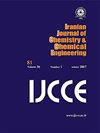Synthesis of rare earth (Dy and Pr) metal impreganated asparagine functionalized CoFe2O4 nanocomposite: Two novel, efficient and magnetically-recoverable catalysts for the reduction of 4-nitrophenol
IF 1
4区 工程技术
Q4 CHEMISTRY, MULTIDISCIPLINARY
Iranian Journal of Chemistry & Chemical Engineering-international English Edition
Pub Date : 2021-11-02
DOI:10.30492/IJCCE.2021.521945.4552
引用次数: 0
Abstract
In recent times biomolecules engineered magnetically isolable nanoparticles have garnered significant attention in nanocatalysis arena due to their outstanding features. Doping of rare earth metals over them brings further novelty in their properties. In this current work we describe the successful synthesis of rare earth lanthanide (M = Pr, Dy) impregnated asparagine adorned CoFe2O4 as two novel magnetically isolable nanocomposite catalyst following post-functionalization approach. The as synthesized materials were characterized using physicochemical techniques like FT-IR, SEM, EDX, elemental mapping and ICP-OES analyses. Subsequently, catalytic efficiency of the materials were investigated in the reduction of 4-Nitrophenol (4-NP), a well-known carcinogenic contaminants of water. Progress of the reaction and its kinetics were monitored over UV-Vis spectroscopy. Among the two variant, Dy anchored catalyst was found to be more efficient than the Pr which led the reaction to completion in just 8 min. Kinetically also Dy catalyst exhibited higher rate constants. This is the first report of Pr and Dy anchored heterogeneous catalyst in the reduction of 4-NP. The current methodology is advantageous in terms of cleanliness, simple procedure, excellent yields in short reaction time, easy magnetic retrieval and reusability of catalysts following several runs without significant change in catalytic activity.稀土(Dy和Pr)金属浸渍天冬酰胺功能化CoFe2O4纳米复合材料的合成:两种新型、高效、磁可回收的4-硝基苯酚还原催化剂
近年来,生物分子工程磁分离纳米颗粒由于其突出的特性在纳米催化领域引起了广泛的关注。在其上掺杂稀土金属,使其性能更加新颖。本文描述了采用后功能化方法成功合成了稀土镧系元素(M = Pr, Dy)浸渍天冬酰胺修饰CoFe2O4作为两种新型磁隔离纳米复合催化剂。利用FT-IR、SEM、EDX、元素图和ICP-OES等理化技术对合成材料进行了表征。随后,研究了这些材料在还原4-硝基酚(4-NP)方面的催化效率,4-硝基酚是一种众所周知的水中致癌污染物。用紫外-可见光谱法对反应过程和动力学进行了监测。在这两种催化剂中,Dy锚定催化剂比Pr锚定催化剂更有效,仅在8分钟内完成反应。动力学上,Dy催化剂也表现出更高的速率常数。本文首次报道了Pr和Dy锚定多相催化剂在4-NP还原中的应用。目前的方法具有清洁、操作简单、反应时间短、收率高、易于磁回收和催化剂多次运行后可重复使用等优点,且催化活性没有明显变化。
本文章由计算机程序翻译,如有差异,请以英文原文为准。
求助全文
约1分钟内获得全文
求助全文
来源期刊

Iranian Journal of Chemistry & Chemical Engineering-international English Edition
CHEMISTRY, MULTIDISCIPLINARY-ENGINEERING, CHEMICAL
CiteScore
2.80
自引率
22.20%
发文量
0
审稿时长
6-12 weeks
期刊介绍:
The aim of the Iranian Journal of Chemistry and Chemical Engineering is to foster the growth of educational, scientific and Industrial Research activities among chemists and chemical engineers and to provide a medium for mutual communication and relations between Iranian academia and the industry on the one hand, and the world the scientific community on the other.
 求助内容:
求助内容: 应助结果提醒方式:
应助结果提醒方式:


